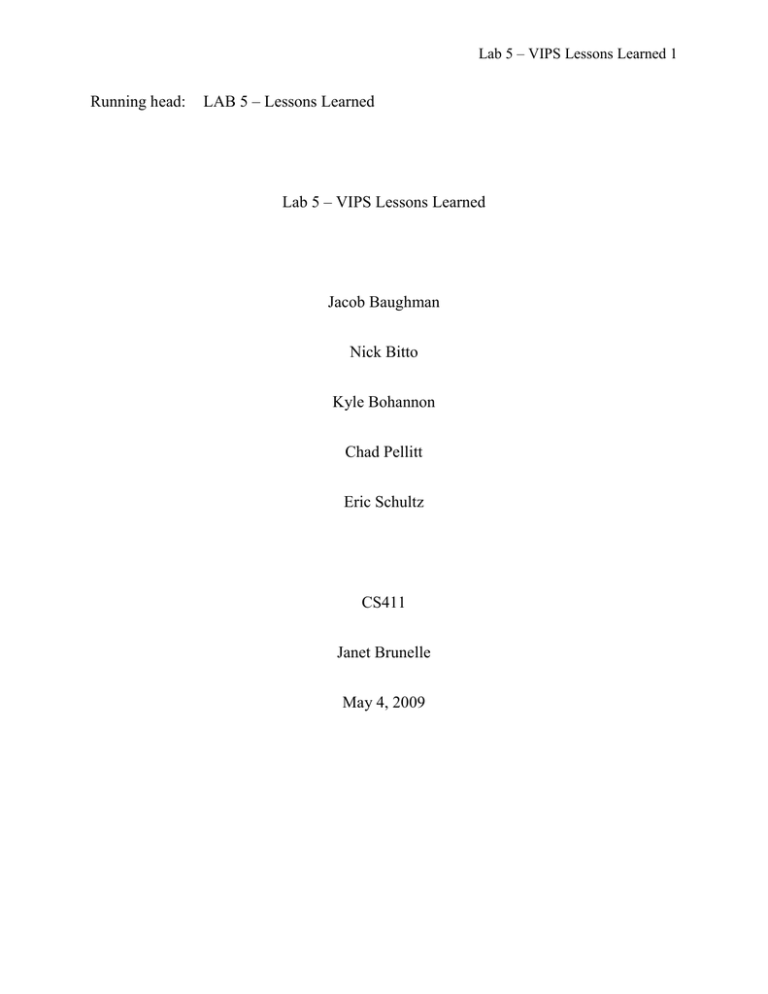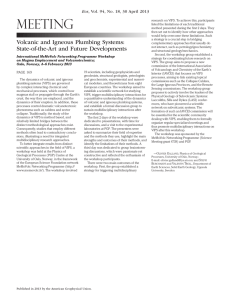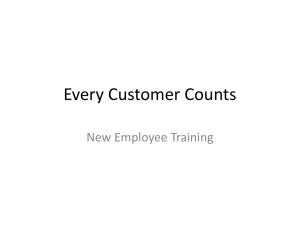Running head: LAB 5 – Lessons Learned Jacob Baughman
advertisement

Lab 5 – VIPS Lessons Learned 1 Running head: LAB 5 – Lessons Learned Lab 5 – VIPS Lessons Learned Jacob Baughman Nick Bitto Kyle Bohannon Chad Pellitt Eric Schultz CS411 Janet Brunelle May 4, 2009 Lab 5 – VIPS Lessons Learned 2 Table of Contents 1 Introduction ............................................................................................................................. 3 2 Risk Management ................................................................................................................... 3 3 Budget ..................................................................................................................................... 7 4 Schedule .................................................................................................................................. 9 5 Prototyping ............................................................................................................................ 10 6 RWP solution and scope ....................................................................................................... 11 List of Figures Figure 1. VIPS Risk Matrix ............................................................................................................ 4 List of Tables Table 1.Price Point for VIPS .......................................................................................................... 7 Table 2. VIPS Phase 2 Staffing Budget .......................................................................................... 8 Table 3. VIPS Phase 2 Hardware Budget ....................................................................................... 9 Lab 5 – VIPS Lessons Learned 3 1 Introduction The VIPS team learned a countless number of lessons from the Old Dominion Computer Productivity Initiative (CPI). The two semesters VIPS has spent together has been an invaluable learning tool. The team started by looking for a societal problem. Once the societal problem was identified, VIPS developed a solution and began the process of developing that solution into a prototype. The first semester of the CPI sequence focused on developing the solution and creating a plan to achieve the solution. VIPS developed business plans, market plans, budgets, and risk analysis. The second semester of CPI focused on the development of the prototype. In order to successfully develop a prototype, VIPS created a detailed requirements document, a test plan, and a user manual. Throughout the entire CPI process VIPS has hit bumps and learned how to develop solution to problems. The VIPS team faced many typical development problems that had to be overcome to deliver a prototype. The process of overcoming problems will help the VIPS team in their next endeavors. 2 Risk Management The VIPS team indentified several risks as part of their work in the first semester of CPI. Figure 1 shows the risk matrix that was developed by VIPS. VIPS used the indentified risks to determine the best way to develop the prototype to minimize the risk. Some risks are unavoidable and cannot be eliminated, in these cases VIPS attempted to mitigate the risk as much as possible. Each of the risks indentified will be discussed in terms of affect on the prototype and VIPS ability to mitigate it. [This Space Intentionally Left Blank] Lab 5 – VIPS Lessons Learned 4 Figure 1. VIPS Risk Matrix 1. Filled Capacity- The filled to capacity risk is a tough risk to mitigate. In terms of the VIPS prototype only a certain number of visitors will be allowed to sign up on a particular day. The attempt to limit the impact on subscription customers is the driving factor, in limiting the number of visitor in each garage. However, the garage being filled up by subscription parkers is more difficult to handle. VIPS cannot create more parking spaces; it can only attempt to more efficiently use the space given. The VIPS prototype will deny users entry into the garage if it is full. The VIPS prototype will also display the amount of space available to mitigate user’s frustration of denial of entry into the garage. The prototype impact of this risk did not change the prototype. Lab 5 – VIPS Lessons Learned 5 2. Loss of Ticket Revenue- The loss of ticket revenue was not handled in the VIPS prototype. Originally, VIPS felt that this risk could be overcome by charging for the visitor pass. The VIPS prototype does not implement a payment feature for the visitor pass. However, in the RWP VIPS would implement whatever payment system the university would like. The VIPS team feels that integrating whatever current payment system the University uses would be the most effective way to handle payment. So, in the RWP the loss of ticket revenue should easily be overcome through implementing a payment system. However, in the prototype the payment system will not be handled. 3. Software Difficulties- As with any computer system the probability is high that software difficulties will occur. VIPS has attempted to limit these by making the interfaces as intuitive as possible. The VIPS website also returns errors when an entry form is not filled out correctly. The error codes and action required to fix the errors is detailed in the VIPS prototype user’s manual. VIPS has mitigated the software errors as much as possible through design and given the user help in overcoming these errors through the use of the user’s manual. 4. Traffic Production- The traffic problem is of great concern in the RWP. In the prototype VIPS attempted to simulate random traffic as much as possible. Randomizing the traffic allows the system to react in a more meaningful and realistic fashion. The VIPS garage simulation can be altered to increase/decrease the rate of cars attempting enter the simulation. The VIPS prototype can efficiently handle the volume of cars. However, in a RWP there will be some additional lag time due to gate lag time and individual driving characteristics. Lab 5 – VIPS Lessons Learned 6 VIPS has attempted to simulate traffic as accurately as possible to show mitigation of this risk. 5. Hardware Failure- Hardware failure happens when dealing with complex computer systems. In the prototype VIPS has very little actual hardware. The only hardware VIPS uses in the prototype in an USB barcode scanner. The VIPS prototype is mainly software driven. In the RWP, VIPS would be responsible for all of the garage hardware but, in the prototype the garage is simulated. Since there is no real hardware this risk did not impact the VIPS prototype. This risk is mainly a concern for a RWP. 6. Visitor Confusion- Visitor confusion is a big risk. If the visitor, or any other users, cannot use the system then VIPS becomes ineffective. The confusion risk played a big part in prototype development. VIPS has attempted to make the user interface extremely easy to use. This has been accomplished by limiting clutter on the pages and only displaying what is needed. VIPS also must ensure that the visitor, or other user, easily interface with the system at the garage. In the VIPS prototype there are display boards to inform users of available spaces in the garage. VIPS believes this shows mitigation of visitor confusion by helping user’s better navigate their way to an available garage. 7. Fraud- Fraud is a risk that must be mitigated. The VIPS prototype is concerned with who can access the system and who can register for a visitor pass. Through the use of access control VIPS will not let any subscription user register for a visitor pass. The VIPS website also only allows individuals with the privileges to Lab 5 – VIPS Lessons Learned 7 invite a guest. The use of access control is the best way for VIPS to mitigate the risk of fraud. In the RWP, VIPS will integrate with the University’s Human Resources database to better protect against fraudulent users. 3 Budget The price point VIPS determined for a three garage system was $22,110.00. The breakdown of the VIPS price point is given in Table 1. VIPS feels like this is still a good estimate. However, these values could change when VIPS move from a lab prototype to a real world prototype. A decent amount of the cost for the RWP is due to garage hardware. Since the VIPS prototype simulates all of the hardware in the garage it is still difficult to determine exact hardware requirements. There have been significant difficulties in developing the software for the prototype. However, VIPS feels, at this point, the difficulties are resolved and should not be passed on to the customer. In further development of the real world prototype, VIPS made need to reassess the price point due to further implementation complications. Hardware Quantity Unit Price Total Barcode Scanner 6 $250.00 $1,500.00 Cisco 851 Router 1 $300.00 $300.00 Cisco Catalyst 2950 Switch 1 $150.00 $150.00 Dell Poweredge Server 1 $1,200.00 $1,200.00 Cat5e Cable + Accessories 1000 ft 6 $150.00 $900.00 Hydraulic Car Counter 6 $310.00 $1,860.00 Terminal 6 $100.00 $600.00 Intercom 6 $100.00 $600.00 $15,000.00 Installation Cost $15,000.00 Software Table 1. Price Point for VIPS $22,110.00 Lab 5 – VIPS Lessons Learned 8 The Phase 2 budget was determined to be $229,640. The Staffing for Phase 2 budget is $215,340 and the hardware budget is $14,300. The Phase 2 staffing and hardware budgets are detailed in Table 2 are Table 3 respectively. There has been a significant more amount of coding in the prototype than was originally thought. In the Phase 2 staffing budget will need to add an additional software developer and an additional database developer. VIPS feels like they can eliminate the parking consultant to make up for the added cost of the software developer and database developer. This will not completely balance the Phase 2 budget so some positions may have to be combined in order to stay under budget, i.e. the combining the risk assessment manager and documentation specialist. Additionally VIPS believes there will be a need for additional hardware to test multiple scenarios. VIPS believes by doubling the hardware budget this will allow testing in two separate environments. Table 2. VIPS Phase 2 Staffing Budget [This Space Intentionally Left Blank] Lab 5 – VIPS Lessons Learned 9 Table 3. VIPS Phase 2 Hardware Budget 4 Schedule The VIPS prototype schedule was very difficult to manage. The VIPS team developed a schedule for the completion of the prototype in the first semester of CPI. The schedule include several items; defining the product description, establishing requirements, creating a test plan, writing a user’s manual, and actually building the prototype. The VIPS team did not allow enough time to develop the requirements, test plans, and user’s manual. VIPS believes they have learned from their mistakes and now understand it takes longer than the two days originally planned to developed requirements. One major lesson learned in this semester of CPI is the vast amount of documentation and writing required to develop a successful prototype. Since VIPS fell behind in the time give for the writing and planning this also pushed back the prototype development. The original amount of time planned to develop the prototype totaled 31 days. The VIPS prototype required a great deal more coding than originally planned. VIPS now know the Lab 5 – VIPS Lessons Learned 10 time required to develop the prototype should most likely be closer to 50 days. The final area VIPS severely fell short on is testing. VIPS scheduled 2 days for testing. Two days is nowhere near enough time to fully integrate five units of software. VIPS also learned the troubles of developing in an environment that they do not control. The VIPS system has components that connect to each other through sockets over networks. This became difficult when VIPS could not open ports and had to defer to a systems group for assistance. VIPS also ran into environmental issues with several of their PHP pages. The pages would not always work on the CS servers. Once again VIPS was not in control of the environment so they had to defer to the systems group. In the future VIPS will allow a more appropriate amount of time for testing. The VIPS Phase 2 schedule can be adjusted give the lessons learned from Phase 1. The Phase 2 schedule currently allows for 5 days of planning. The planning period needs to be readjusted to 20 days. In the planning phase VIPS will determine the flaws of the lab prototype and redesign to ensure the lab prototype will work in the real world prototype. VIPS allocated 27days for the development of the real world prototype. The development period should be adjusted to allow for 45 days for development. The final adjustment to the Phase 2 schedule will be in the testing period. The testing period currently allows for only 5 days. Through the lesson learned in the lab prototype that is not nearly enough time. The phase 2 schedule should reflect 15 days for testing. The increases in amount of time given to planning, development, and testing will increase the overall schedule by 43 days. This is a significant increase in time for Phase 2. However, VIPS wants to ensure an adequate product is developed and tested in Phase 2. 5 Prototyping The VIPS prototype. Lab 5 – VIPS Lessons Learned 11 1. Database 2. Test Harness 3. Engine 4. Garage Simulation 5. Website 6 RWP solution and scope In the development of the VIPS prototype several obstacles had to be overcome in order to for a successful prototype to be developed. However, VIPS feels like the RWP solution is still valid. The major issues in developing the prototype were environment and connectivity driven. VIPS feels confident that when they can control the environment these errors will be eradicated. Furthermore, the logical algorithms of the VIPS system were proven to be successful and that is the major innovative aspects of the prototype. At this time VIPS does not feel it is necessary to make changes to the RWP. Nevertheless, VIPS is cognizant of the fact that they may run into development problems integrating garage hardware. Since a garage simulation was used to test the VIPS system there may be unforeseen issues with integrating garage hardware. Another major lesson VIPS has learned is to stay flexible and ready to resolve future complications.

